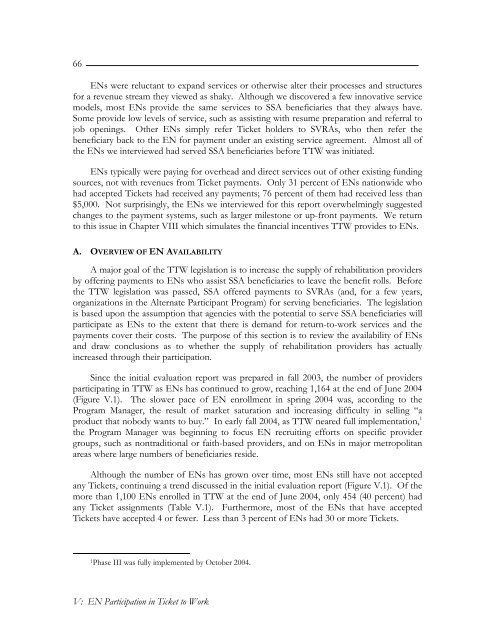Evaluation of the Ticket to Work Program, Implementation ...
Evaluation of the Ticket to Work Program, Implementation ...
Evaluation of the Ticket to Work Program, Implementation ...
Create successful ePaper yourself
Turn your PDF publications into a flip-book with our unique Google optimized e-Paper software.
66ENs were reluctant <strong>to</strong> expand services or o<strong>the</strong>rwise alter <strong>the</strong>ir processes and structuresfor a revenue stream <strong>the</strong>y viewed as shaky. Although we discovered a few innovative servicemodels, most ENs provide <strong>the</strong> same services <strong>to</strong> SSA beneficiaries that <strong>the</strong>y always have.Some provide low levels <strong>of</strong> service, such as assisting with resume preparation and referral <strong>to</strong>job openings. O<strong>the</strong>r ENs simply refer <strong>Ticket</strong> holders <strong>to</strong> SVRAs, who <strong>the</strong>n refer <strong>the</strong>beneficiary back <strong>to</strong> <strong>the</strong> EN for payment under an existing service agreement. Almost all <strong>of</strong><strong>the</strong> ENs we interviewed had served SSA beneficiaries before TTW was initiated.ENs typically were paying for overhead and direct services out <strong>of</strong> o<strong>the</strong>r existing fundingsources, not with revenues from <strong>Ticket</strong> payments. Only 31 percent <strong>of</strong> ENs nationwide whohad accepted <strong>Ticket</strong>s had received any payments; 76 percent <strong>of</strong> <strong>the</strong>m had received less than$5,000. Not surprisingly, <strong>the</strong> ENs we interviewed for this report overwhelmingly suggestedchanges <strong>to</strong> <strong>the</strong> payment systems, such as larger miles<strong>to</strong>ne or up-front payments. We return<strong>to</strong> this issue in Chapter VIII which simulates <strong>the</strong> financial incentives TTW provides <strong>to</strong> ENs.A. OVERVIEW OF EN AVAILABILITYA major goal <strong>of</strong> <strong>the</strong> TTW legislation is <strong>to</strong> increase <strong>the</strong> supply <strong>of</strong> rehabilitation providersby <strong>of</strong>fering payments <strong>to</strong> ENs who assist SSA beneficiaries <strong>to</strong> leave <strong>the</strong> benefit rolls. Before<strong>the</strong> TTW legislation was passed, SSA <strong>of</strong>fered payments <strong>to</strong> SVRAs (and, for a few years,organizations in <strong>the</strong> Alternate Participant <strong>Program</strong>) for serving beneficiaries. The legislationis based upon <strong>the</strong> assumption that agencies with <strong>the</strong> potential <strong>to</strong> serve SSA beneficiaries willparticipate as ENs <strong>to</strong> <strong>the</strong> extent that <strong>the</strong>re is demand for return-<strong>to</strong>-work services and <strong>the</strong>payments cover <strong>the</strong>ir costs. The purpose <strong>of</strong> this section is <strong>to</strong> review <strong>the</strong> availability <strong>of</strong> ENsand draw conclusions as <strong>to</strong> whe<strong>the</strong>r <strong>the</strong> supply <strong>of</strong> rehabilitation providers has actuallyincreased through <strong>the</strong>ir participation.Since <strong>the</strong> initial evaluation report was prepared in fall 2003, <strong>the</strong> number <strong>of</strong> providersparticipating in TTW as ENs has continued <strong>to</strong> grow, reaching 1,164 at <strong>the</strong> end <strong>of</strong> June 2004(Figure V.1). The slower pace <strong>of</strong> EN enrollment in spring 2004 was, according <strong>to</strong> <strong>the</strong><strong>Program</strong> Manager, <strong>the</strong> result <strong>of</strong> market saturation and increasing difficulty in selling “aproduct that nobody wants <strong>to</strong> buy.” In early fall 2004, as TTW neared full implementation, 1<strong>the</strong> <strong>Program</strong> Manager was beginning <strong>to</strong> focus EN recruiting efforts on specific providergroups, such as nontraditional or faith-based providers, and on ENs in major metropolitanareas where large numbers <strong>of</strong> beneficiaries reside.Although <strong>the</strong> number <strong>of</strong> ENs has grown over time, most ENs still have not acceptedany <strong>Ticket</strong>s, continuing a trend discussed in <strong>the</strong> initial evaluation report (Figure V.1). Of <strong>the</strong>more than 1,100 ENs enrolled in TTW at <strong>the</strong> end <strong>of</strong> June 2004, only 454 (40 percent) hadany <strong>Ticket</strong> assignments (Table V.1). Fur<strong>the</strong>rmore, most <strong>of</strong> <strong>the</strong> ENs that have accepted<strong>Ticket</strong>s have accepted 4 or fewer. Less than 3 percent <strong>of</strong> ENs had 30 or more <strong>Ticket</strong>s.1 Phase III was fully implemented by Oc<strong>to</strong>ber 2004.V: EN Participation in <strong>Ticket</strong> <strong>to</strong> <strong>Work</strong>
















